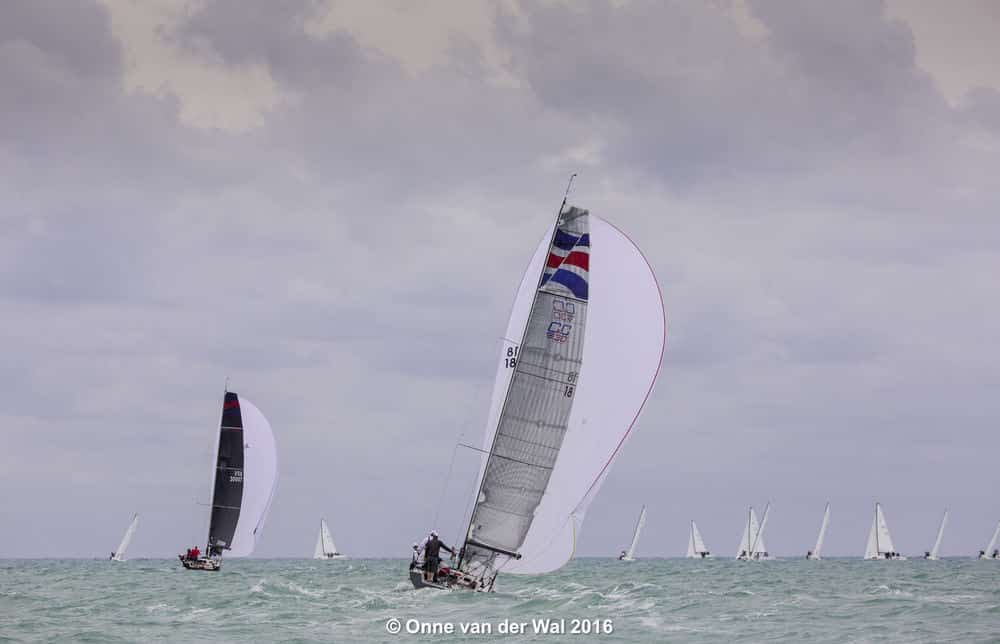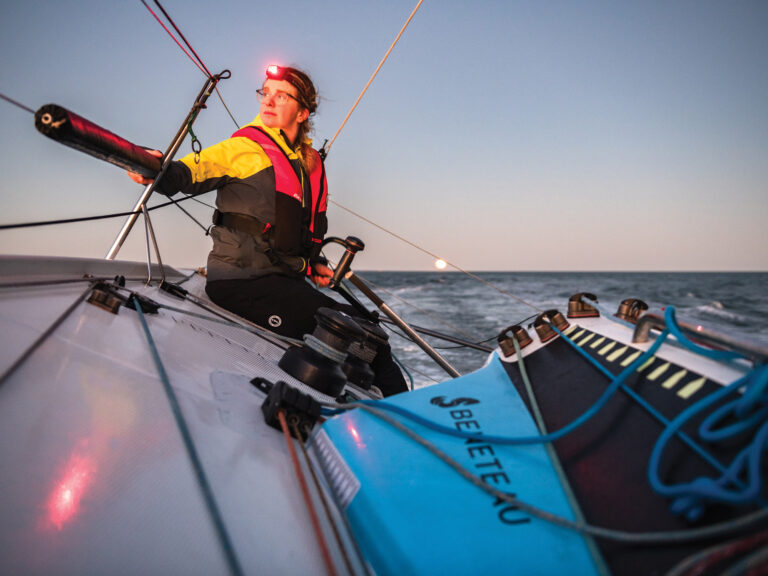
Frequently, the first portion of a run in a large fleet can feel like a cruise-ship conga line, especially when all the boats are sailing in displacement mode. Everyone rounds the windward mark on starboard tack, sets the spinnaker, and then points their bow right at the transom of the boat ahead of them. The only thing missing is the annoying soundtrack and umbrella drinks.
The head of this train is an enviable position—everyone wants to be in front—but it also means making a difficult decision: how and when to bail out of the parade and head back toward the center of the course, hopefully without all the trailing boats on your breeze.
The first thing you need to consider is the skew of the run from your position. The longer the port jibe, the more you need to think about leading the pack back toward the bottom mark.
On a boat with a navigator, the computer will tell you the leg bias and time remaining on each jibe. For a typical TP52 downwind leg, for example, a perfectly square run would have along the lines of 9 minutes on starboard and 9 minutes on port. But the racecourse is never perfect. And as you proceed away from the windward mark on starboard tack, you’re pushing off to one side. So you should always be thinking about the run in terms of the long jibe.
All things being equal, the tipping point to bail out of the starboard parade is when the port jibe is getting so long that the first boat that jibes will have clean air on port and any boat that
extends farther on starboard runs the risk of sailing to the leeward mark in dirty air, or overstanding and being forced to come in at a tighter than optimal angle. Usually, I find that point is when you have approximately 2 minutes of sailing on starboard jibe until you reach the port-jibe layline for the leeward mark.
But what if you don’t have a navigator, or a fancy GPS-based computer to study? Think about the previous beat you just sailed. Did you spend more time on starboard or port? If the majority of the beat was spent on starboard, then port will be the long jibe downwind and vice versa. Don’t get too lost in the math of determining which jibe is the long one. If the beat is close to square, you’re going to have to spend some time on port. Getting your air clear for that portion of the run is key.
When I’m getting down to the final 30 percent of my time on starboard, assuming all things are equal with pressure and current, I will match the first boat in the line-up that jibes, be it the second, third, or fourth, or even farther back. Hopefully it’s the third (or farther back), as that requires less effort to defend. When the two lead boats jibe simultaneously, they often end up in a grudge match, which can present a great opportunity for trailing boats to sail past both. By matching the third or fourth boat in this scenario, the lead boat creates a wider wind blanket for anybody that sails farther toward the port-jibe layline, reducing the possibilities of the second-place boat passing through to leeward. Most importantly, though, you are keeping your bow out, in clean air, and you’re on the long jibe to the leeward gate.
Tactically, it is important to be in line with the boats behind. You don’t want to be high and have somebody a half a length inside your line behind. This puts the trailing boat in position to match your jibe and be in a very strong spot once you’re both on port. If that happens, it will be all but impossible to prevent them from getting on your air and closing down the gap, or rolling over you altogether.
The entire team needs to be tuned into doing a smooth maneuver. That means everybody is ready to execute a jibe but doesn’t signal the impending maneuver. The element of surprise is key.









